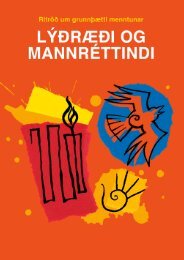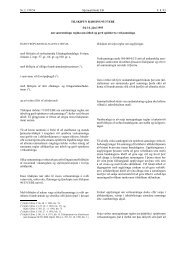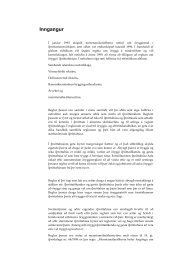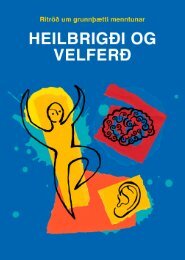Arts and Cultural Education in Iceland : Professor Anne Bamford
Arts and Cultural Education in Iceland : Professor Anne Bamford
Arts and Cultural Education in Iceland : Professor Anne Bamford
You also want an ePaper? Increase the reach of your titles
YUMPU automatically turns print PDFs into web optimized ePapers that Google loves.
‣ Icel<strong>and</strong>ic education is dedicated to build<strong>in</strong>g the skills <strong>and</strong> knowledge <strong>in</strong> the arts forms,<br />
especially visual arts, music, wood craft <strong>and</strong> textile <strong>and</strong> to a lesser extent dance,<br />
drama, photography <strong>and</strong> film mak<strong>in</strong>g.<br />
‣ <strong>Arts</strong> programmes <strong>in</strong> Icel<strong>and</strong> embed ideals of quality <strong>and</strong> this is evident <strong>in</strong> the fluency<br />
with which most Icel<strong>and</strong>ic students are able to work with<strong>in</strong> the languages of the arts.<br />
‣ More focus needs to be given to develop<strong>in</strong>g creativity <strong>in</strong> schools through creative<br />
approaches to learn<strong>in</strong>g , <strong>in</strong>clud<strong>in</strong>g <strong>in</strong> the arts<br />
Learn<strong>in</strong>g the languages of the arts enables people to talk effectively about their arts<br />
experiences <strong>and</strong> express their feel<strong>in</strong>gs. The arts are a powerful form of communication. The<br />
development of language skills appeared to be central with<strong>in</strong> the design <strong>and</strong> implementation of<br />
arts-rich education <strong>in</strong> Icel<strong>and</strong>. From an early age, the substantial commitment to arts lessons<br />
means that Icel<strong>and</strong>ic children are fluent <strong>in</strong> the language of arts discipl<strong>in</strong>es – such as the language<br />
of colour, movement, gesture <strong>and</strong> so on. Furthermore, the overall importance given to arts<br />
with<strong>in</strong> Icel<strong>and</strong>ic society means that, even if the pupils <strong>in</strong> later life do not wish to be active <strong>in</strong><br />
expression through the arts, they possess ways to talk about arts <strong>and</strong> culture so they can<br />
participate actively <strong>in</strong> the cultural life of Icel<strong>and</strong> <strong>and</strong> beyond.<br />
Language has an important function to perform <strong>in</strong> giv<strong>in</strong>g students the words to enable<br />
children to talk about their artwork, performance <strong>and</strong> the work of artists. Children will develop<br />
this vocabulary with <strong>in</strong>terest<strong>in</strong>g questions from the teacher or artist <strong>and</strong> by talk<strong>in</strong>g to each other<br />
about their arts experiences. Concurrently, both the ability to express oneself through artistic<br />
means <strong>and</strong> to be able to talk <strong>and</strong> write about artistic <strong>and</strong> cultural experiences, gives the child a<br />
greater range of ways to express feel<strong>in</strong>gs. In this way, the arts are a powerful form of<br />
communication. The build<strong>in</strong>g of the critical languages of the arts was less developed <strong>in</strong> pupils<br />
than both their generally excellent expressive (arts) languages <strong>and</strong> their languages of arts<br />
appreciation.<br />
The arts provide a language that enables society to pass on cultural heritage to young<br />
people. Importantly, it also allows young people to create their own artistic language <strong>and</strong> to<br />
contribute to their global development (emotional <strong>and</strong> cognitive). In this way it equips young<br />
people with the capacity to develop the cultural heritage of the future.<br />
The arts are symbolic communications that act as a cultural driv<strong>in</strong>g force accentuated the<br />
role of the arts <strong>in</strong> social action, social reconstruction <strong>and</strong> the role of culture <strong>in</strong> society. For this<br />
purpose alone, there is ample justification to foreground the need for systematic development<br />
of artistic languages. Effective arts education comb<strong>in</strong>es development <strong>in</strong> the specific languages of<br />
the arts with creative approaches to learn<strong>in</strong>g.<br />
Despite the high level of discipl<strong>in</strong>e specific skills <strong>and</strong> knowledge with<strong>in</strong> Icel<strong>and</strong>ic pupils, the<br />
idea that the arts are a form of language <strong>and</strong> that ‘literacy’ <strong>in</strong> the arts is vital for contemporary<br />
<strong>and</strong> future society – especially <strong>in</strong> the light of the rapid changes <strong>in</strong> communication technologies –<br />
notions of visual literacy, aesthetic literacy, sound literacies <strong>and</strong> so on was not equally apparent<br />
<strong>in</strong> either policy or practice <strong>in</strong> Icel<strong>and</strong>. The area of <strong>in</strong>tegrated creative languages appears to be<br />
underdeveloped <strong>in</strong> debates <strong>and</strong> classroom practices <strong>in</strong> arts <strong>and</strong> cultural education <strong>and</strong> beyond <strong>in</strong><br />
Icel<strong>and</strong> (see later section on <strong>in</strong>tegration). The need to develop broader ‘creative’ languages was<br />
seen by representatives of the creative <strong>in</strong>dustry sectors to be a vital <strong>and</strong> urgent role of education<br />
<strong>in</strong> Icel<strong>and</strong>, as these statements emphasise:<br />
The focus needs to be on creativity, not just pa<strong>in</strong>t<strong>in</strong>g <strong>and</strong> putt<strong>in</strong>g it on the wall, but someth<strong>in</strong>g to do with how<br />
children actually th<strong>in</strong>k; open<strong>in</strong>g up all the areas of the arts. A lot of this has got to do with the director of the<br />
school. In Icel<strong>and</strong> we need <strong>in</strong>dividuals with a sense of creativity. We need these people to be strong for bus<strong>in</strong>ess<br />
<strong>and</strong> to be able to be creative. To become creative is an urgent issue; we need this. The school system is how it<br />
68



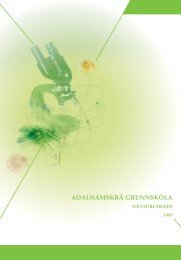
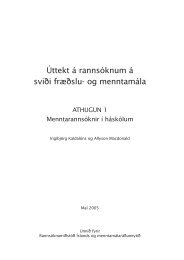

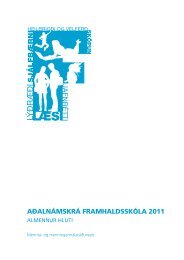
![Aðalnámskrá tónlistarskóla : rytmÃsk tónlist [Eingöngu á rafrænu formi]](https://img.yumpu.com/50843672/1/184x260/aaalnamskra-tanlistarskala-rytma-sk-tanlist-eingangu-a-rafranu-formi.jpg?quality=85)
